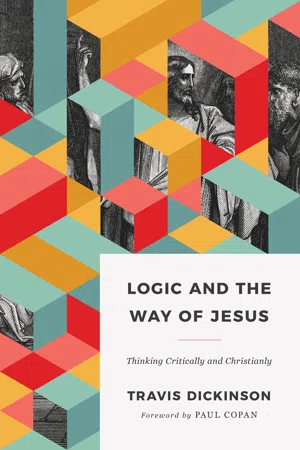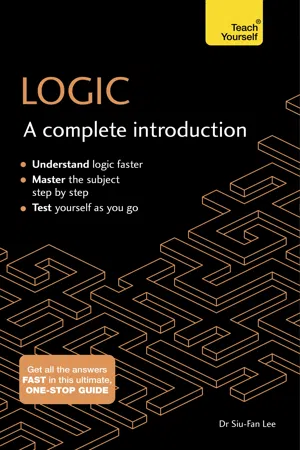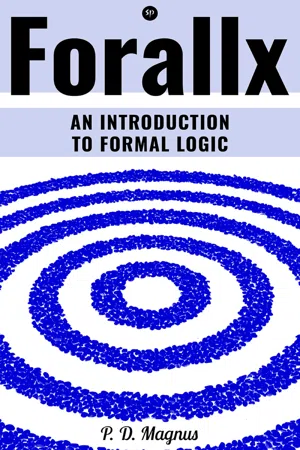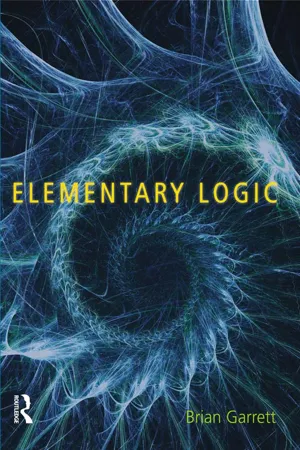Truth Table
A truth table is a mathematical table used in logic to determine the truth value of a compound statement based on the truth values of its components. It lists all possible combinations of truth values for the statement's variables and shows the resulting truth value of the statement for each combination. Truth tables are commonly used in computer science for designing and analyzing digital circuits and programming logic.
7 Key excerpts on "Truth Table"
- eBook - ePub
Logic and the Way of Jesus
Thinking Critically and Christianly
- Travis Dickinson(Author)
- 2022(Publication Date)
- B&H Academic(Publisher)
...Truth Tables A ll statements are bivalent. This means that for every statement there are exactly two truth values. It is always either true or false. Given this fact about statements, we can represent the truth values for P in a table: P T F We call this a “Truth Table,” which is a diagram that displays all the possible combinations of truth values of a statement or a series of statements. The top row is the statement letter and the two rows below this present all possible truth values for the statement. Truth Tables are useful for displaying the logical possibilities, and seeing these possibilities helps us understand the complex statements we’ve described above. It will also give us yet another way to test for validity. The table above shows the logical possibilities for the simple statement P, and there are only two: it can be either true or false. That’s it. There are no other logical possibilities. So far, so good! Simple Statements Represented When, however, we have more than one statement involved, it gets more complicated. We have more logical possibilities of truth values, and so we must represent that in our Truth Table. To represent the logical possibilities of two simple statements, it looks like this: P Q T T F T T F F F Notice that if we have two statement letters, then there twice as many possibilities of combinations for the truth values. They can both be true, P can be false and Q true, P can be true and Q false, or both could be false. Every time we add a new letter, we must expand the table so that we can represent all the different logical possibilities. The more statement letters you have, the more possible combinations of truth values. How do you know how many rows you will need? If you have one statement, then you need two rows. If there are two statements, then you need four rows...
- eBook - ePub
- Siu-Fan Lee(Author)
- 2017(Publication Date)
- Teach Yourself(Publisher)
...From this, we infer that at least one of the premises of this argument is false. The short truth-table method to be introduced in the next section makes use of this strategy. We shall discuss it further there. To summarize, we have introduced the truth-table method for testing validity in this section. A truth-table is a complete list of all possible truth-value assignments of a proposition. We list all possible truth-value assignments of propositions in an argument, then proceed to check whether it is possible to obtain a case in which all the premises are true while the conclusion is false. If it is impossible, then the argument is valid. If it is possible, then the argument is invalid. The truth-table method is a general method for checking validity. There are some common argument forms already known to be valid or invalid. By identifying these argument forms, we can easily determine the argument’s validity without drawing a truth-table, though of course, such proofs are available if we wish to draw their truth-tables. The truth-table method works because a truth-table is a complete and exhaustive device to show all possible truth-value combinations. This is reminiscent of the rationale for the Venn diagram method in categorical logic. In categorical logic, the method works because a Venn diagram crafts the logical space into a number of areas exhaustively and reveals the complete set of possibilities for each area to have an object in it. Thus, everything is transparent to the mind. Nothing is hidden and nothing escapes attention as long as an agent is cautious enough to run or check a test. There is no hidden agenda, and there is no need for any mysterious cognitive faculties like speculation, inspiration, revelation or premonition. Moreover, the truth-table method is effective, in that every argument can be determined, within a definite number of steps, to be either valid or invalid...
- eBook - ePub
- J. Gibson(Author)
- 2013(Publication Date)
- Routledge(Publisher)
...The behaviour of any single-output combinational logic circuit may be described by a table which is similar to Table 2.2 but has only one output column. Table 2.3 is an example of one possible table for a circuit with three inputs. Table 2.3 is called a Truth Table and it completely specifies the behaviour of a particular logic circuit. The rules for constructing a Truth Table are that there must be separate columns for each input and for each output (as indicated previously, circuits may have more than one output but can be divided into separate single-output circuits). The table must have one row for each possible combination of input states, every possible input combination must be included and the output(s) produced by the circuit must be shown in all cases. A Truth Table is a clear and easily understood method of describing the behaviour of a combinational logic circuit. Since it also provides an exact definition of the circuit operation, a Truth Table should be included as part of the specification of any combinational logic circuit. Table 2.3 2.2 A set of basic logic elements It was stated earlier that 2 2 n different logic circuits may be specified which have n inputs and a single output. Each one of these circuits has its own unique Truth Table. If n is 2 there are sixteen possible circuits, when n is 3 there are two hundred and fifty-six and so on. The number increases rapidly with n and it would be an uneconomic proposition to manufacture different circuits for every possible case...
- eBook - ePub
- Harry Gensler(Author)
- 2002(Publication Date)
- Routledge(Publisher)
...be true or false (the two truth values) —represented by “1” and “0.” There are four possible truth-value combinations: PQ 0 0 Both are false 0 1 Just Q is true 1 0 Just P is true 1 1 Both are true In the first case, I went to neither Paris nor Quebec. In the second, I went to Quebec but not Paris. And so on. A Truth Table gives a logical diagram for a wff. It lists all possible truth-value combinations for the letters and says whether the wff is true or false in each case. The Truth Table for “·” (“and”) is very simple: PQ (P·Q) 0 0 0 1 1 0 1 1 0 0 0 1 “I went to Paris and I went to Quebec.“”(P·Q)” is a conjunction ; P and Q are its conjuncts. “(P’Q)” claims that both parts are true. So “I went to Paris and I went to Quebec” is false in the first three cases (where one or both parts are false)—and true only in the last case. These truth equivalences give the same information: (0·0)=0 (false·false)=false (0·1)=0 (false·true)=false (1·0)=0 (true·false)=false (1·1)=1 (true·true)=true Here “(0·0)=0” says that an AND statement is false if both parts are false. The next two say that an AND is false if one part is false and the other part is true. And “(1·1)=1” says that an AND is true if both parts are true. 1 Here are the Truth Table and equivalences for “∨” (“or”): PQ (P∨Q) 0 0 0 1 1 0 1 1 0 1 1 1 (0∨0)=0 (0∨1)=1 (1∨0)=1 (1∨1)=1 “I went to Paris or I went to Quebec.” “(P∨Q)” is a disjunction ; P and Q are its disjuncts. “(P∨Q)” claims that at least one part is true. So “I went to Paris or I went to Quebec” is true if I went to one or both places; it’s false if I went to neither place...
- eBook - ePub
- P.D. Magnus(Author)
- 2018(Publication Date)
- Studium Publishing(Publisher)
...In the previous chapter, we wrote the characteristic Truth Tables with ‘T’ for true and ‘F’ for false. It is important to note, however, that this is not about truth in any deep or cosmic sense. Poets and philosophers can argue at length about the nature and significance truth, but the truth functions in SL are just rules which transform input values into output values. To underscore this, in this chapter we will write ‘1’ and ‘0’ instead of ‘T’ and ‘F’. Even though we interpret ‘1’ as meaning ‘true’ and ‘0’ as meaning ‘false’, computers can be programmed to fill out Truth Tables in a purely mechanical way. In a machine, ‘1’ might mean that a register is switched on and ‘0’ that the register is switched off. Mathematically, they are just the two possible values that a sentence of SL can have. The Truth Tables for the connectives of SL, written in terms of 1s and 0s, are given in table 3.1. The characteristic Truth Table for conjunction, for example, gives the truth conditions for any sentence of the form (A & B). Even if the conjuncts A and B are long, complicated sentences, the conjunction is true if and only if both A and B are true. Consider the sentence (H & I) → H. We consider all the possible combinations of true and false for H and I, which gives us four rows. We then copy the truth-values for the sentence letters and write them underneath the letters in the sentence. Now consider the subsentence H & I. This is a conjunction A & B with H as A and with I as B. H and I are both true on the first row. Since a conjunction is true when both conjuncts are true, we write a 1 underneath the conjunction symbol. We continue for the other three rows and get this: The entire sentence is a conditional A → B with (H & I) as A and with H as B. On the second row, for example, (H & I) is false and H is true. Since a conditional is true when the antecedent is false, we write a 1 in the second row underneath the conditional symbol...
- eBook - ePub
- Brian Garrett(Author)
- 2014(Publication Date)
- Routledge(Publisher)
...If a complex formula contains n atomic formulae, it will have 2 n rows in its truth-table. Thus, for example, A & (B ∨ C) will have 2 3 (= 8) rows: The column under the main connective of the formula (&) is displayed in bold print. Truth-functionality A connective or sentence-forming operator is truth-functional just if the truth-table for the connective has no gaps. That is, the truth-value of any complex sentence or formula containing only truth-functional connectives is fixed by the truth-values of its contained sentences or formulae. Our five symbolic connectives are truth-functional. But English contains many sentence-forming operators that are not truth-functional. Consider, for example, ‘Bob believes that …’. ‘Bob believes that snow is white’ is not a truth-function of ‘snow is white’. The truth-value of ‘snow is white’ does not, by itself, determine the truth-value of ‘Bob believes that snow is white’. What determines the truth-value of ‘Bob believes that snow is white’ is not the truth-value of ‘snow is white’, but Bob’s psychology. Some have thought we need a special (non-truth-functional) epistemic logic in order to display the logical behaviour of operators such as ‘Bob believes that …’, ‘Bob knows that.’ and so on. Modal operators (‘possibly’ and ‘necessarily’) are similarly non-truth-functional and have their own logics. Chapter 13 gives further elaboration. Two uses for truth-tables 1 All complex formulae constructed using only our five connectives have complete (gap-free) truth-tables. The column under the main connective (hereafter, the main column) of any formula tells us everything about the logical profile of the formula. In particular, it tells us whether the formula is contingent or a tautology or a contradiction. The main column of any formula falls into one of the following three categories: (a) it consists of a mixture of Ts and Fs; (b) it consists of all Ts; (c) it consists of all Fs. If the main column is a mix, the formula is contingent...
- eBook - ePub
- Irving Copi, Carl Cohen, Daniel Flage(Authors)
- 2016(Publication Date)
- Routledge(Publisher)
...If there are four simple statements, there will be four guide columns with sixteen rows below the variables. And so forth. 7 It is essential that you set up the guide columns in a systematic way so that you’ll have all the possible combinations of truth values in the Truth Table. Starting from the left, put a T in each successive row until you have a T in half the rows under the guide column; then put an F in the remaining rows. As you proceed to the right, vary the frequency with which you change truth values twice as often for each successive column. The right-most guide column will vary the truth value every other row. The guide columns for Truth Tables with one, two, and three guide columns should look like this: Once you have constructed the guide columns, you construct a column for each compound statement. Consider the truth-functional compound ~ (p • q). This is the negation of the conjunction of p with q. We should expect, then, that ~ (p • q) will always have the opposite truth value of (p • q). If we want to determine its truth conditions precisely, we can construct a Truth Table. First you fill in a column for (p • q). Use the guide columns together with the definition of the dot (•) to determine the truth values in every row: Now you add a column for ~ (p • q): Notice that the column for ~ (p • q) has a T wherever the column for p • q has an F, and vice versa. The Truth Table shows that the truth values for ~ (p • q) are just what we would expect. Consider the compound statement form (q ∨ ~ p). To construct the Truth Table, proceed just as we did above. Step 1: Sketch the Truth Table and fill in the guide columns. Step 2: To determine the truth value of the propositional form (q ∨ ~ p), you need to determine the truth value of ~ p. Always begin by determining the truth values of the component propositions of the compound proposition or propositional form for which you wish to determine the truth value...






